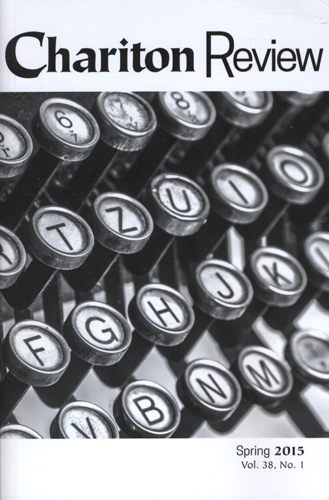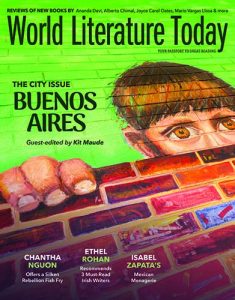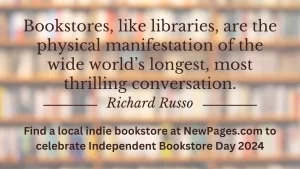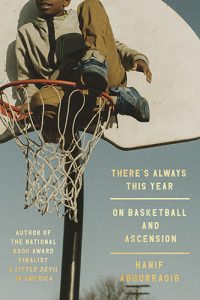Chariton Review – Spring 2015
Doesn’t everybody just love a winner? Especially when it comes to reading the winning entries of a writing contest published in a journal’s newest issue. Chariton Review’s Spring 2015 issue starts off with the winner and finalists of their short fiction prize, judged by Christine Sneed. And, let’s be honest: the reason we love these as readers (and maybe writers ourselves) is because we want to see if we agree with the judge! Doesn’t everybody just love a winner? Especially when it comes to reading the winning entries of a writing contest published in a journal’s newest issue. Chariton Review’s Spring 2015 issue starts off with the winner and finalists of their short fiction prize, judged by Christine Sneed. And, let’s be honest: the reason we love these as readers (and maybe writers ourselves) is because we want to see if we agree with the judge!
Jo de Waal’s “Sugar Bowl” took the prize, and of the finalists presented here, I can say that I do agree with Sneed, but I imagine hers was a tough decision to make. de Waal’s first-person narrator succinctly details that boring, awkward experience of babysitting in someone’s house, though the ending brings about a surprising turn that reveals the babysitter’s unwitting participation in some undefined mental/emotional issues of the mother character. “Big Sisters” by Louise Kantro examines the relationship between two women—aunt and niece—as the niece is thrown by misfortune into the lives of her relatives. It’s a gentle yet honest assessment of these kinds of family dynamics that are hard to define—is aunt now mother? big sister?— yet have to find a place in our lives. I enjoyed the cultural exploration inherent in Mike Lewis-Beck’s “Delivery in Göteberg.” Lennart, working for Pharmacist Herr Sohlberg, makes a prescription delivery to a man dying of cancer. It’s the interactions and dialogue of the different characters that make the story here, which is otherwise just ‘slice of life.’ And the final finalist, Kim Norris’s work “Die Laughing.” Warning: This is a CLOWN story! As even the story notes, there are those people who are truly, deathly afraid of clowns. As if bringing together a clown, a death, and an undertaker into one story wasn’t enough, add disruptive child/parent relationships that (perhaps) are finally resolved for the daughter in the end.
There is only one nonfiction piece included in this issue, “The Age of Lichens” by Sarah Gilbert. But it’s enough, because I completely fell in love with this piece and couldn’t have given my heart to another. This is seriously unabashed nonfiction in which Gilbert tells of her break up and subsequent divorce coupled with her overwhelming maternal drive to want to have more children before it’s too late in her reproductive life. She intersperses this life narrative with information about (of all things) lichens. She is a tour guide volunteer at a local waterfall park where she encounters lichens, is asked questions about them by tourists, and meets up with a biologist who can share in this interest with her. Gilbert creates lovely parallels between her life and her struggles with the lives of lichen—which ones grow better in relationships with what other natural elements and so on. I love this kind of writing that can take me from honestly saying I wouldn’t have cared about something—like lichens or David Douglas or Archibald Menzies—to knowing, caring, and wanting to know more about it. As Gilbert writes, “The Douglas fir is not a fir. In common parlance it also bears, not the name of the man who first categorized it, but his rival. The Pseudostuga menziesii is one of the most important commercial trees in the world.” She writes that neither Douglas nor Menzies, as she learned from her research, had children, connecting this back to her life. This is tight nonfiction given the varied directions Gilbert takes readers in her narrative collage.
As for the poetry included in this issue, none of it comes easy. There are forms that challenge the readier, as in each of Derek Mong’s four poems, and works that challenge psychologically, as in “The Woodchuck’s Song” by Patricia Corbus:
. . . while svelte buzzards idly twirled
over rafts of dead alewives washing onto shore,
I saw a woman on the beach pick upa plastic bag, jerk it angrily over her head
& twist a rope of pearls around her neck
to shut off all the air—but suddenlya motorcycle drove past fast looking for her
or the end of the road.
I can’t “make sense” of this kind of imagery, but I follow it more with feeling in a kind of lucid dreamscape. There are other such fleeting images that arise from the language, as in Robert Bense’s “A Postcard from Afternoon”:
Silent sibilance of dunes
their lazy curl of infinity
testing time
inched toward ever closer thresholds
of the suburbs.
And the fantastical, as in “The Dragonfly” by Rebecca Lilly:
A phantasmal genie
with diaphanous wings, a hanging jewel,
it lights on clouds
drifting upstream.At dusk the wind huffs and puffs
the lunar carousel around, and an elf
rides the dragonfly
through the Valley of Death.
Those poems that are narrative in some semblance tend toward dark life matter, as in Clarie Scott’s “Appointment” which describes a mother taking her son to see medical specialists:
To board first
Passengers’ eyes averted
In fear or pity
I help with his canes
His body twisted
Torqued in pain
His eyes hollow
Or as in Richard Spilman’s “The Roaster,” which has parents realizing their bulimic child (daughter?) has been secretly continuing her purging: “Then we found it, a roaster full of vomit / hidden in a corner of the cedar closet.”
To wrap up the issue, Chariton Review includes an “End Table” in which the editor poses a question to writers whose works are included. For this issue, Editor James D’Agostino wanted to “find out how much our writers don’t know. More specifically: we want to hear our writers speak about the connections between not-knowing and discovery that make the creative process such a baffling and lovely struggle.” Specifically, he asked, “What surprises and discoveries did you encounter in the process? What made the whole thing click into place?” He got some great answers from a number of authors, and it made me wish there was more of this kind of discussion available for readers in journals. Some of the poets offered commentary that helped me better appreciate their works, which I then went back and reread with greater depth and new vision. It’s a tough call, right? The writing should stand on its own—but it’s also what I like when I go hear poets read live. I like when they introduce a work, give some backstory, and then read. Admittedly, some works that left me completely baffled, that I may not have given much consideration to, I went back and found myself able to connect with. So, maybe sometimes, offering readers a bit of insight isn’t the worst thing in the world.
Chariton Review is a breath of fresh variety in the literary world. This issue was particularly heavy on the poetry, featuring multiple works from the same author—a generous offer of page real estate for writers and opportunity for readers to better get to know a particular author. I’d like to see more fiction and nonfiction of the variety the editors already show a penchant and so look forward to future issues of this publication.
[tsup.truman.edu/aboutChariton.asp]




